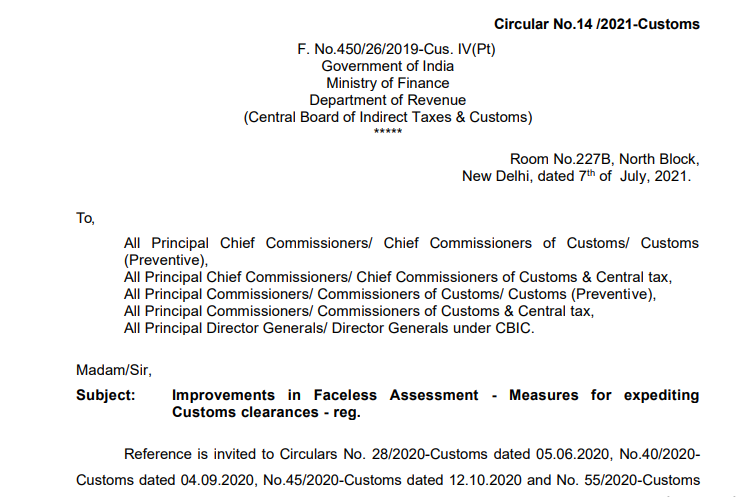Improvements in Faceless Assessment – Turant Faceless Scheme
Introduction-
New CBIC introduced the ‘Turant – Faceless Assessment’. This is introduced to reduce the manual work. CBIC wants to increase automation. It is one of the measures from many to improve cross-border business. India ranks very low on ease of doing business. It is at 63rd number of world banks chart. Although there is the improvement of 17 points in a year. But we want to improve it even more. Thus a series of measures like SWIFT, e-Sanchit, Revise AEO program, RFID e-seal program is introduced.
“Turant faceless scheme” is one of these schemes.
Circular No. 14 /2021-Customs for Faceless Assessment under Turant faceless scheme
Subject: Improvements in Faceless Assessment – Measures for expediting Customs clearances – reg.
Reference is invited to Circulars No. 28/2020-Customs dated 05.06.2020, No.40/2020- Customs dated 04.09.2020, No.45/2020-Customs dated 12.10.2020 and No. 55/2020-Customs dated 17.12.2020, which put together detail the rollout of Faceless Assessment pan India w.e.f. 31.10.2020 and clarify/streamline certain processes for its effective implementation.
2. Board has recently comprehensively reviewed the implementation of Faceless Assessment and deliberated on the further measures required for expediting the pace of assessment and Customs clearance of imported goods. Board finds that by and large the objectives of Faceless Assessment in terms of expeditious assessments, anonymity in assessments, and uniformity in assessments have been met. However, Board observes that there is even now scope for improvement which would potentially lead to a substantial increase in the pace of assessments and Customs clearance, while further enhancing the uniformity in assessments and anonymity with a view to reducing interface with the trade.
3. Accordingly, Board has decided to implement the following measures in the Customs Faceless Assessment and clearance processes:
3.1 Enhancement of facilitation levels:
Board has earlier reviewed the facilitation levels in imports and vide Circular No. 39/2011-Customs dated 02.09.2011 decided the facilitation targets should be 80% for Aircargo Complexes, 70% for Seaports and 60% for ICDs. Various initiatives have since been taken to leverage technology as well as simplify extant procedures. As a result, on Page 2 of 14, the overall average facilitation levels have already exceeded these levels with the All-India average facilitation level across all Customs stations being 77% for May 2021. Board also notes that the use of machine learning and the other state of art technologies now enables RMS to more precisely target the risky consignments thereby enabling more focussed attention on a lesser number of Bills of Entry for assessment by the FAGs. Thus, Board has decided that w.e.f. 15.07.2021 the facilitation level across all Customs stations would be increased to 90% relating to RMD. It is clarified that the element of randomness in the interdiction of any Bill of Entry would be retained by RMS. This measure is expected to enable faster clearance of non-risky imports with an enhanced focus on risky imports so that revenue remains safeguarded. The aforementioned circular stands are modified accordingly.
3.2 Expediting assessment process:
Board observes that, at present, the working hours of the FAGS across the country are not uniform. Thus, there is uneven output such that some officers of a FAG who begin work earlier clear more than the targeted Bills of Entry while others whose working hours begin later do not get a sufficient number of Bills of Entry. Moreover, the time take for the ‘first decision’ by the Appraising Officers and Deputy/Assistant Commissioners of Customs is also much more than necessary resulting in lower than optimum output. Accordingly, with a view to facilitating faster decisions and, in turn, faster verification of self-assessment as well as to promote specialization and enhance uniformity in assessment, Board has decided to implement changes in the assessment procedure, as follows –
Read & Download the full Circular in pdf:

 ConsultEase Administrator
ConsultEase Administrator
Consultant
Faridabad, India
As a Consultease Administrator, I'm responsible for the smooth administration of our portal. Reach out to me in case you need help.







